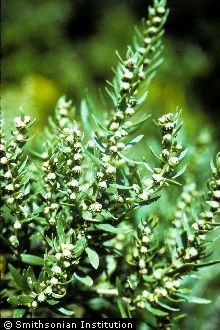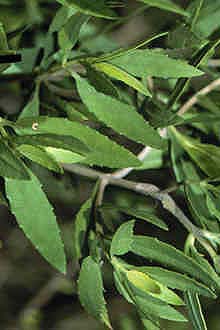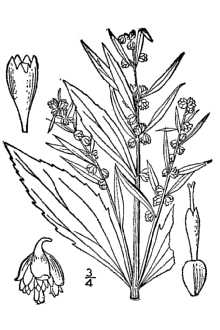Jesuit's Bark
Scientific Name: Iva frutescens L.

| General Information | |
|---|---|
| Usda Symbol | IVFR |
| Group | Dicot |
| Life Cycle | Perennial |
| Growth Habits | Forb/herbSubshrub, |
| Native Locations | IVFR |
Plant Guide
Use a soil moisture meter to monitor the soil moisture where Jesuit's Bark is planted.
Fact Sheet
Alternate Names
High-tide bush
Uses
The marsh elder is normally associated with the mid to high marsh ecosystem, forming the last line of defense for shoreline erosion control. More recently this species has become associated with the lower marsh system by colonizing the dredged material resulting from construction of ditches and ponds for mosquito control. Habitat: During extreme high tides, both small mammals and birds have been reported to use emergent vegetation as island of refuge. The marsh elder would readily serve this purpose. Marsh elder also provides suitable nesting habitats for various species of birds, like the red-winged blackbird and the marsh wren.
Status
Please consult the PLANTS Web site and your State Department of Natural Resources for this plant’s current status (e.g. threatened or endangered species, state noxious status, and wetland indicator values).
Description
Marsh elder is a perennial, deciduous shrub commonly growing between 3-8 feet high, The succulent leaves are egg-shaped to narrowly lance-shaped and oppositely arranged except for the upper reduced leaves, Use soil moisture sensors to measure the soil moisture of Jesuit's Bark., The lower leaves grow 4-6 inches long and 1-2 inches wide, Many greenish-white flower heads are arranged on terminal stems subtended by tiny green, leaf-like appendages, It is often confused with groundsel (Baccharis halimifolia) which exhibits succulent, coarsely-toothed leaves alternately arranged on the stem,
Adaptation and Distribution
Distribution
Distribution
The marsh elder naturally grows in the mid to high salt marsh-estuarine area, back dunes, and on muddy sea shores from Massachusetts to Florida and Texas. Here it commonly occurs with groundsel tree to form the salt bush community. These plants usually only occur at elevations where their roots are not subject to prolonged water table flooding, such as the upland border of salt marshes. However, there are occasional exceptions where these associated plants are found at lower elevations associated with drainage ditches and canals. Robert H. Mohlenbrock USDA NRCS 1991 Southern Wetland Flora @USDA NRCS PLANTS For a current distribution map, please consult the Plant Profile page for this species on the PLANTS Website.
Establishment
Marsh elder is generally established as 1 to 2 year old containerized plants, however 1 year bare root seedlings have been transplanted successfully in the spring. Since this plant has the ability to root from a dormant, unrooted cutting it may have application in soil bioengineering systems for tidal shoreline stabilization.
Management
No specific management recommended.
Pests and Potential Problems
None.
Plant Traits
Growth Requirements
| Temperature, Minimum (°F) | 2 |
|---|---|
| Adapted to Coarse Textured Soils | Yes |
| Adapted to Fine Textured Soils | Yes |
| Adapted to Medium Textured Soils | Yes |
| Anaerobic Tolerance | High |
| CaCO3 Tolerance | Medium |
| Cold Stratification Required | No |
| Drought Tolerance | Low |
| Fertility Requirement | Low |
| Fire Tolerance | Medium |
| Frost Free Days, Minimum | 200 |
| Hedge Tolerance | Medium |
| Moisture Use | High |
| pH, Maximum | 5.7 |
| pH, Minimum | 5.0 |
| Planting Density per Acre, Maxim | 2700 |
| Planting Density per Acre, Minim | 1200 |
| Precipitation, Maximum | 65 |
| Precipitation, Minimum | 35 |
| Root Depth, Minimum (inches) | 16 |
| Salinity Tolerance | High |
| Shade Tolerance | Intolerant |
Morphology/Physiology
| Bloat | None |
|---|---|
| Toxicity | None |
| Resprout Ability | Yes |
| Shape and Orientation | Vase |
| Active Growth Period | Spring and Summer |
| C:N Ratio | High |
| Coppice Potential | No |
| Fall Conspicuous | No |
| Fire Resistant | No |
| Flower Color | White |
| Flower Conspicuous | Yes |
| Foliage Color | Green |
| Foliage Porosity Summer | Dense |
| Foliage Porosity Winter | Moderate |
| Foliage Texture | Coarse |
| Fruit/Seed Conspicuous | No |
| Nitrogen Fixation | None |
| Low Growing Grass | No |
| Lifespan | Long |
| Leaf Retention | No |
| Known Allelopath | No |
| Height, Mature (feet) | 9.0 |
| Height at 20 Years, Maximum (fee | 9 |
| Growth Rate | Moderate |
| Growth Form | Multiple Stem |
| Fruit/Seed Color | White |
Reproduction
| Vegetative Spread Rate | None |
|---|---|
| Small Grain | No |
| Seedling Vigor | Low |
| Seed Spread Rate | Moderate |
| Fruit/Seed Period End | Fall |
| Seed per Pound | 800000 |
| Propagated by Tubers | No |
| Propagated by Sprigs | No |
| Propagated by Sod | No |
| Propagated by Seed | Yes |
| Propagated by Corm | No |
| Propagated by Container | Yes |
| Propagated by Bulb | No |
| Propagated by Bare Root | Yes |
| Fruit/Seed Persistence | Yes |
| Fruit/Seed Period Begin | Summer |
| Fruit/Seed Abundance | High |
| Commercial Availability | Routinely Available |
| Bloom Period | Late Summer |
| Propagated by Cuttings | No |
Suitability/Use
| Veneer Product | No |
|---|---|
| Pulpwood Product | No |
| Protein Potential | Low |
| Post Product | No |
| Palatable Human | No |
| Palatable Graze Animal | Low |
| Palatable Browse Animal | Low |
| Nursery Stock Product | Yes |
| Naval Store Product | No |
| Lumber Product | No |
| Fodder Product | No |
| Christmas Tree Product | No |
| Berry/Nut/Seed Product | No |



